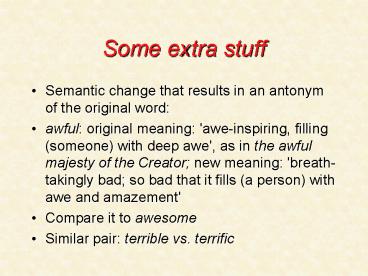Some extra stuff - PowerPoint PPT Presentation
1 / 22
Title:
Some extra stuff
Description:
Some extra stuff Semantic change that results in an antonym of the original word: awful: original meaning: 'awe-inspiring, filling (someone) with deep awe', as in the ... – PowerPoint PPT presentation
Number of Views:91
Avg rating:3.0/5.0
Title: Some extra stuff
1
Some extra stuff
- Semantic change that results in an antonym of the
original word - awful original meaning 'awe-inspiring, filling
(someone) with deep awe', as in the awful majesty
of the Creator new meaning 'breath-takingly
bad so bad that it fills (a person) with awe and
amazement' - Compare it to awesome
- Similar pair terrible vs. terrific
2
Some extra stuff
- cool vs. hot they could be both positive (e.g.
Thats really cool hot buys) but not always
(e.g. hot check) - Intermediate ones like lukewarm do not have
positive or negative meanings.
3
Computational Linguistics
- Ling 400
4
What is Linguistics good for?
- Language teaching
- Medical speech therapy for aphasic patients
- Computer-related applications
- Computational linguistics (also called natural
language processing, language engineering)
computer simulation of human language processes
5
Some online materials
- Some relevant information including a lecture by
Prof. Emily Bender is available from the
following web site. - http//depts.washington.edu/llc/olr/linguistics/in
dex.php
6
Computational Linguistics
- encoding/production speech synthesis, word
processing help, production side of an expert
system, generation of sentences in the target
language in machine translation. - decoding/understanding speech recognition,
parsing, disambiguation via a network of semantic
relations.
7
Language Production
- thinking cannot be simulated
- speech/writing computer simulation of speech
sounds is possible to some extent. Computer can
help this process with a grammar checker, an
input system and a word breaker (in a language
like Japanese). But these tasks do not simulate
what people actually do when they talk.
8
Language Production (2)
- Though not part of the natural production
process, turning speech into written text has
some practical applications. - This is very useful because speaking is usually
quicker than writing. It would be like having a
personal secretary. - This is also useful for someone who cannot write
because of disability or injury.
9
Language Understanding
- speech recognition difficult but possible if the
domain is restricted (e.g. speaker and/or
expected input types) Why is this difficult? - syntactic analysis parsing (syntactic analysis
by computer) is possible but needs
semantic/pragmatic information for disambiguating
instances of structural ambiguity. - Interpretation (truth conditions) unclear as to
how to simulate this usually done via semantic
representations (in some machine translation
systems).
10
Ambiguity Resolution
- The astronomer saw a comet with a telescope.
- The astronomer saw a comet with a brilliant tail.
- How do we solve its ambiguity?
- One needs to know some information about seeing
and comets.
11
Semantic Network
12
Concrete Applications
- corpus linguistics
- machine translation
- text retrieval
- text summarization
- word processing help (discussed above)
- expert systems
- speech recognition/synthesis (touched upon above)
- toys, games
- automatic telephone interpretation system
- ultimately artificial intelligence, robotics
13
Corpus Linguistics
- This is a generic name for various computer
applications that make use of large language
databases (called corpora) - Having access to a large database enabled us to
process linguistic data in a statistical way,
rather than in an analytical way. - This conflict of two opposing views (statistical
vs. analytical) is very apparent in machine
translation.
14
Machine Translation (1)
- text-to-text translation (great need for
translation at UN, EC (European Community) - Works best when two languages in question are
similar in structure - Usually, pre-editing and/or post-editing by a
human translator is required machine-assisted
translation.
15
Machine Translation (2)
- Traditionally, MT required parsing, possibly some
semantic analysis, then mapping to a syntactic
tree of the sentence in the target language. - An alternative is appeal to statistical means of
mapping a surface string in the source language
to a surface string in the target language. - http//www.excite.co.jp/world/english/web/
16
Machine Translation (3)
- Difficulty with word-for-word translation
- Watasi-ni-wa futari kodomo-ga imasu.
- I -at-top two child-nom exist
- Literally, As for me as a location, two
children exist - Actually, its meaning is I have two children.
17
Computational Semantics
- The study of how to automate the process of
constructing and reasoning with meaning
representations of natural language expressions. - This could play an important role in such
application areas as machine translation when two
typologically distinct languages are involved
(e.g. English and Japanese).
18
Text Retrieval
- key word ? text/book
- key word morphology
- Principles of Polymer Morphology
- Image Analysis and Mathematical Morphology
- Drainage Basin Morphology
- French Morphology
- We need morphological, syntactic, and semantic
information to find the right text/book. - Further applications search engines, etc.
19
Text Summarization
- We need to be able to select the right
information from the electronic documents
available (esp. on the web). - Automatic text summarization is a technique that
can help people to quickly grasp the concepts
presented in a document by creating an abstract
or summary of the original text.
20
Semantic Web
- Some people (e.g. Evergreen U) are trying to
classify contents of web pages so that they are
meaningful to computers. But this is not an easy
task since the categories must presumably be
pre-selected by people. - The semantic Web provides a common framework that
allows data to be shared and reused across
application, enterprise, and community
boundaries. http//www.w3.org/2001/sw/
21
Speech Recognition/Synthesis
- actually being used on personal computers (on a
limited basis), automated telephone answering
system, etc. - Application of acoustic phonetics, phonology
22
AI and robotics
Furby
Aibo































